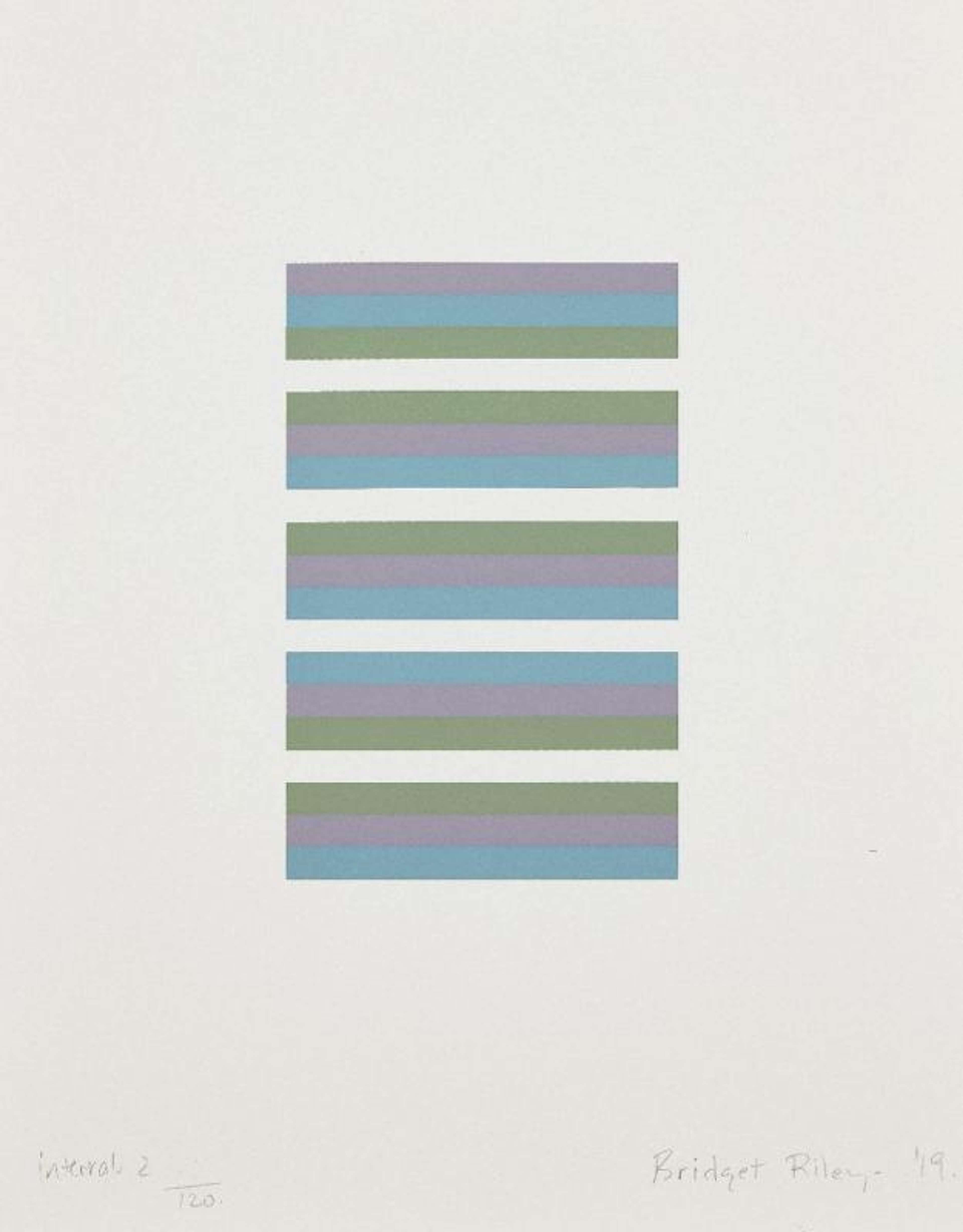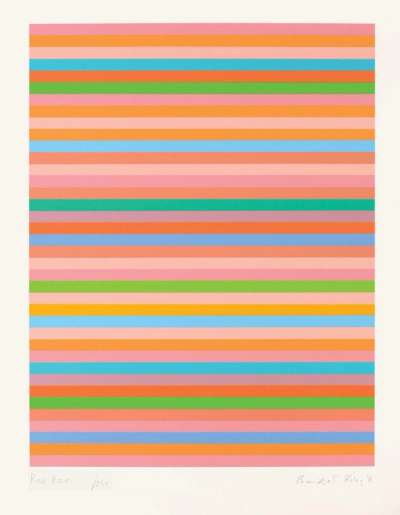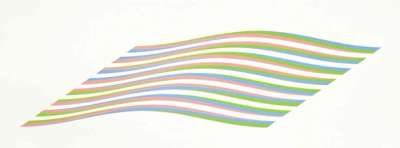 Image © Youtube @Sotheby's / Bridget Riley standing in front of a Mondrian
Image © Youtube @Sotheby's / Bridget Riley standing in front of a Mondrian
Bridget Riley
111 works
Bridget Riley, a paramount figure in the realm of optical art, has long been recognised for her dynamic explorations of visual perception through abstract compositions. Her work, characterised by its meticulous geometric precision and vibrant interplays of colour, owes a significant debt to the pioneering innovations of Piet Mondrian. He has had a profound impact on her artistic practice and her exploration of the sensory experience in art. Riley's engagement with Mondrian's work not only informed her understanding of abstraction but also inspired her to investigate the boundaries of visual perception.
First Exposures: Broadway and Victory Boogie Woogie
Riley's first exposure to Mondrian's work marked a pivotal moment in her artistic development, which began with her encounter with Broadway Boogie Woogie in 1942. This painting, a celebrated piece in the collection of the Museum of Modern Art in New York, stands out in Mondrian's body of work for its vibrant grid of colourful squares that mimic the bustling streets of Manhattan and generate a lively rhythm that resonates with optical energy—an effect Riley would emulate. The dynamic composition and use of colour significantly impressed her as a student, showcasing the potential of abstract art to capture the essence of modern life and its rhythms.
Riley's admiration for Mondrian's work deepened following her visit to New York in 1965. At this time, Riley's work was being featured in The Responsive Eye exhibition at the Museum of Modern Art and in a solo show at the Richard Feigen gallery. It was during this trip that she visited the home of art collectors Burton and Emily Hall Tremaine and encountered Victory Boogie Woogie (1944), Mondrian's last painting, in person. This artwork left a profound impression on Riley, with Hall Tremaine recalling Riley's declaration of the painting as 'the greatest influence on her work.' Victory encapsulates Mondrian's advanced abstraction principles, integrating a lively palette and a fragmented surface that suggests a ceaseless dynamic movement, reminiscent of the boogie woogie music that inspired both it and Broadway Boogie Woogie. This encounter underscored Riley's engagement with abstract art's potential for expressing motion and emotion through geometric forms and colour, influencing her subsequent exploration into optical and kinetic art.
Riley's early fascination with Mondrian's work, particularly these two paintings, underscores a shared interest in conveying the vibrancy and rhythm of contemporary life through abstract compositions. For Riley, Mondrian's ability to distil musicality and urban energy into geometric abstraction resonated with her own artistic quest to create visually stimulating works that engage the viewer's perception and evoke a sense of movement.
Riley on "Mondrian: The 'Universal' and the 'Particular'"
Apart from being one of the most notable artists of our time, Riley is also an excellent academic. She has written several essays about Mondrian, including ‘Mondrian: The Universal and The Particular’ for The Burlington Magazine in 1996. Here, she uses Mondrian’s own writings to make informed assertions about his work; namely, that his artistic vision is deeply rooted in the concepts of "dynamic equilibrium" and "equivalence of the dissimilar," which offer a profound insight into his approach to abstract painting. These principles suggest a departure from the art historical canon of seeking aesthetic harmony through idealistic speculation. Instead, Mondrian focuses on the pictorial, where form, line and colour interact within a framework of balance and contrast, avoiding any finality or absolute resolution. His work embodies a meticulous process of engaging these elements not as isolated entities but as parts of a coherent visual system, which is neither absorbed into a singular totality nor fragmented into discrete, self-sufficient units. Through this intricate relational dynamic, Mondrian's paintings transcend traditional representations, redefining the elements of art in terms of their collective impact on spatial perception and compositional balance.
This transformative approach is achieved through what Mondrian termed 'destruction,' an essential mechanism in his creative process that dismantles the conventional identities of colour and form. By subjecting these elements to a network of opposing forces within the canvas, Mondrian reinvents them as expressive components of a larger pictorial order. Each painting becomes a site of tension and resolution, where the interplay of elements gives rise to a complex visual harmony that mirrors the flux of life itself. This duality—between the universal and the particular, the static and the dynamic—encapsulates Mondrian's lifelong pursuit of a painting style that reflects the inherent complexities and rhythms of existence. Through his innovative use of abstraction, Mondrian challenges the viewer's perception and underscores the potential of painting to capture the essence of reality in its most distilled and dynamic form.
This approach resonates deeply with Riley’s own artistic practice, one keenly based on geometry and visual tension and which focuses much on the viewer’s interaction and ocular perception of the work. Her ability to academically interact with Mondrian’s work is illustrative of the amount of time she has spent reflecting and studying his methods and mindset.
 Image © Amazon / Catalogue Cover for the Exhibition Mondrian: Nature to Abstraction
Image © Amazon / Catalogue Cover for the Exhibition Mondrian: Nature to Abstraction'Mondrian, Nature to Abstraction’ at the Tate
In 1997, the Tate invited Riley to co-curate an exhibition on Mondrian’s work alongside Sean Rainbird. She provided an "artist's eye view" of his legacy, working alongside Rainbird to select works that illustrated Mondrian's enduring relevance and pioneering spirit in abstract art. With the Gemeentemuseum—home to the world's largest collection of Mondrian's art—undergoing renovations, the Tate Gallery seized this opportunity to host a collection of around sixty works from the Dutch museum, supplemented by pieces from its own collection and other prestigious institutions. This arrangement allowed for a rich presentation of Mondrian's oeuvre, including lesser-seen works and a series that tracks his evolution from naturalistic depictions to the threshold of abstraction. Riley played a significant role in the curation and conceptualisation of the show.
Her insights into Mondrian's philosophy and methodology underscored the profound impact of his work on her own artistic journey and on the broader trajectory of 20th-century art. She emphasised Mondrian's exploration of Abstract/Realism, where the interplay of lines and colours on the canvas constituted a new form of "reality" for the artist – a concept that has informed her own understanding of abstraction. Moreover, Riley made evident how much she admires Mondrian's relentless pursuit of innovation, pushing the boundaries of his art to achieve a sophisticated realism that continually evolved until his death. The exhibition served as a timely exploration of abstraction, inviting viewers to engage with the challenges and opportunities it presents to contemporary artists.
Mondrian's Impact on Riley's Artistic Practice
Mondrian's profound influence on Riley's artistic practice is a testament to his wider legacy in the realm of abstract art. Her engagement with his work provided her with a foundational understanding of abstract principles that deeply informed her own artistic development. Mondrian's method of engaging form, line, and colour in a complex interplay to transcend their conventional identities resonated with Riley, inspiring her to explore similar concepts in her work.
Mondrian's philosophy of Abstract/Realism, where the canvas becomes a realm of 'real' interactions between lines and colours, offered Riley a new lens through which to view the visual reactions in her work. This concept challenged her to consider the canvas not just as a surface for depiction but as a space where reality is constructed and experienced through abstract relationships. Riley learned much from Mondrian about the importance of a systematic exploration of form and colour, applying these lessons to her own practice in ways that would redefine optical and kinetic art. Her work, much like his, seeks to engage the viewer in a dynamic visual experience, where perception is continually challenged and invigorated by the interplay of geometric shapes and vibrant hues. Riley's contribution to curating the Mondrian exhibition at the Tate not only underscored her deep respect for his work but also highlighted the significant parallels in their artistic quests—both driven by an unwavering commitment to abstraction and a belief in its power to express the complexities of reality.
Through her admiration and scholarly engagement with Mondrian's work, Riley has demonstrated how his pioneering spirit and innovative techniques continue to inspire artists to explore the expressive potential of abstract art. His impact on Riley's artistic practice is a vivid example of how the legacy of one artist can profoundly shape the trajectory of another, fostering a dialogue across generations that enriches the landscape of contemporary art.


















